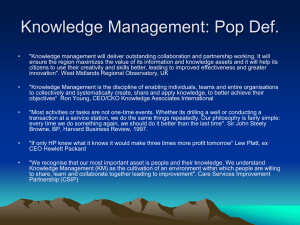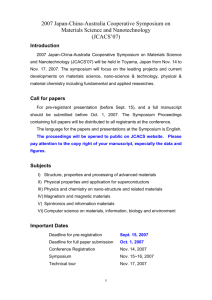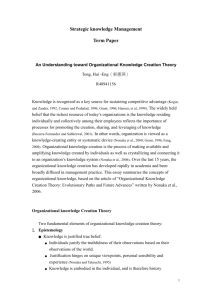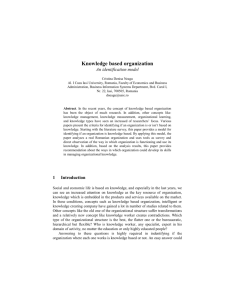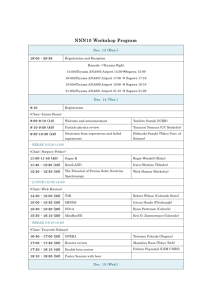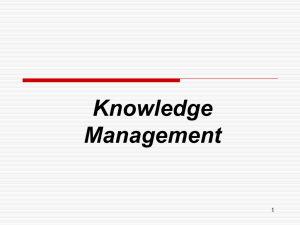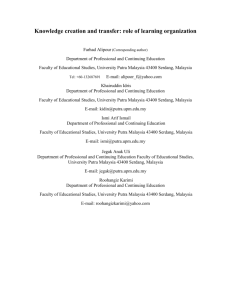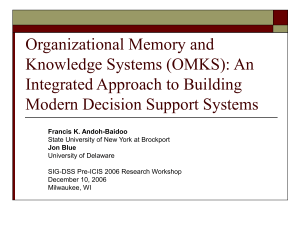What is Knowledge?
advertisement
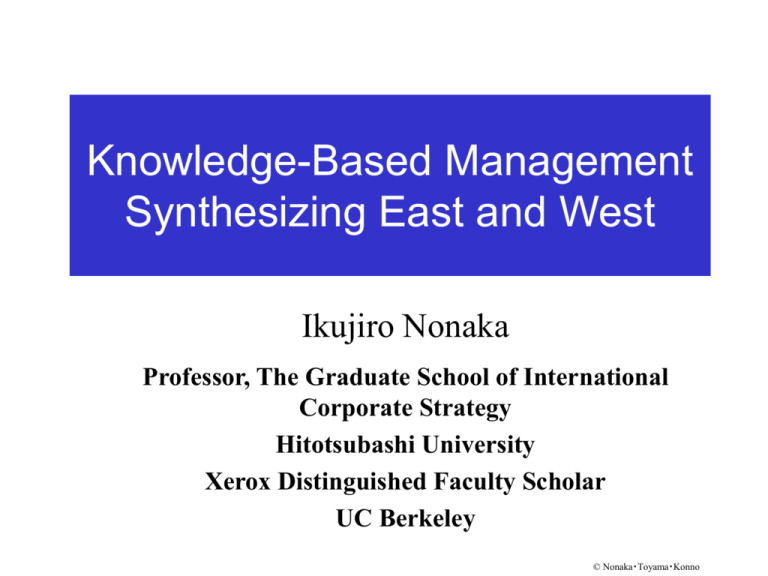
Knowledge-Based Management Synthesizing East and West Ikujiro Nonaka Professor, The Graduate School of International Corporate Strategy Hitotsubashi University Xerox Distinguished Faculty Scholar UC Berkeley © Nonaka・Toyama・Konno Why Knowledge? “Knowledge is the only meaningful resource today.” Peter Drucker (1993) Knowledge is one of the most important assets of an organization for creating value and, hence, maintaining sustainable competitive advantage. © Nonaka・Toyama・Konno Characteristics of Knowledge 1. Increasing Return 2. Unlimited Usage 3. Unseparated Production and Consumption 4. Difficulties in Market Transaction 5. New Value by Re-categorization 6. Quickly Outdated 7. Created by Human Beings © Nonaka・Toyama・Konno What is Knowledge? In Western Epistemology: “Justified True Belief” The belief must be true, and the truthfulness must be justified. But what is truth? “There are no whole truths; all truths are half-truths.” (Whitehead, 1954) © Nonaka・Toyama・Konno What is Knowledge? Other aspects of Knowledge: Multi-perspective Context-specific, relational and dynamic - created in social interactions Aesthetic Values - Endless pursuit of truth, goodness, and beauty Hence, we define Knowledge as: “A dynamic human process of justifying personal belief towards the truth.” © Nonaka・Toyama・Konno Simon’s Metaphor: A Man is an Ant - Bounded Rationality or Cognitive Limits Direction to Home A man, viewed as a behaving system, is quite simple. The apparent complexity of his behavior over time is largely a reflection of the complexity of the environment in which he finds himself. Simon, H.A.(1982) The Sciences of the Artificial. © Nonaka・Toyama・Konno Views of Human Beings in Knowledge-Creating Paradigm All men by nature desire to know. (Aristotle) Man is a purposive animal. (Nicholas Rescher) Man exists in relationships. (Kitaro Nishida) © Nonaka・Toyama・Konno Two Types of Knowledge Tacit Knowledge Subjective and experiential knowledge that can not be expressed in words, sentences, numbers, or Formulas (Context-specific) Cognitive Skills beliefs images perspectives mental models Technical Skills Explicit Knowledge Objective and rational knowledge that can be expressed in words, sentences, numbers, or formulas (context-free) Theoretical approach Problem solving Manuals Database craft know-how Dynamic Interaction Analog-Digital Synthesis © Nonaka・Toyama・Konno Tacit and Explicit Knowledge “The strength of Japanese manufacturing industries are at the technologies (based on) tacit knowledge. With the progress in Information Technology (IT), tacit knowledge is converted into explicit knowledge. Still, we need tacit knowledge. To build a car, we have to build people.” -Hiroshi Okuda, the chairman of Toyota Without a firm-specific high quality tacit knowledge, a firm cannot survive just by combining explicit knowledge through outsourcing. A company needs to recognize a dispersed tacit knowledge embedded in people, synthesize tacit and explicit knowledge, and incorporate knowledge into key organizational activities for continuous innovation. © Nonaka・Toyama・Konno Reality has Duality - Subjectivity and Objectivity Tacit Insider sensitivity Life world Commitment Here and now Phenomenologist Existentialist Explicit Outsider objectivity Factual world Detachment There and then Positivist Spectator © Nonaka・Toyama・Konno SECI Process Sharing and creating tacit knowledge through direct experience Environment I I Group Individual I I I I Tacit Internalization G O I 9. embodying explicit knowledge through action and reflection 10. Using simulation and experiments O I E E Explicit Combination E G G Org. G G Explicit I = Individual, G = Group, O = Organization, E = Environment Explicit Learning and acquiring new tacit knowledge in practice Externalization Explicit 1.Perceiving the reality as it is 2. Sensing and Empathizing with others and the environment 3. Transferring of tacit knowledge Tacit Socialization Articulating tacit knowledge through dialogue and reflection 4. articulating tacit knowledge using symbolic language 5. translating tacit knowledge into a concept or prototype Systemizing and applying explicit knowledge and information 6. gathering and integrating explicit knowledge 7. Breaking down the concept and finding relationship among concepts 8. editing and systemizing explicit knowledge © Nonaka・Toyama・Konno Basic Components of Knowledge-creating Organization Environment Vision (Ecosystem) (What?) Dialogue (Why?) Driving Objectives Practice (How?) Ba (Shared Context) © Nonaka・Toyama・Konno Knowledge Vision Knowledge Vision - Essential Questioning: “What do we exist for?” “Where should we live?” (Existence and Domain) “Why do we create knowledge?” A vision that transcends the existing boundary. A vision that can be accepted by and can inspire the people with various contexts. -Gives the firm an absolute, not a relative, value system. “You do it because you want to do it, not because everyone else is doing it.” -A long-time view that goes beyond the arena of competition. It is not a short-time view on efficiency in knowledge utilization. © Nonaka・Toyama・Konno Why do we create knowledge?: A story of Honda Honda was trying to develop the CVCC engine, which had lower emission and higher fuel efficiency. Souichiro Honda, the founder and then CEO of Honda one day told his engineers that the engine would finally give Honda the opportunity to beat Big 3. The engineers looked at Mr. Honda, and said, “Please, don’t say such a thing. We are not doing this to beat other guys. We are doing this for our children.” Mr. Honda was ashamed of himself, and said that he realized that he had become too old, and decided to retire. © Nonaka・Toyama・Konno Driving Objective It is a concept, goal, or codes of conduct to synchronize vision, dialogue, and practice. By pursuing it relentlessly, contradictions are created and synthesized to create high quality of knowledge. Seven-Eleven Japan: Cut opportunity losses Eisai: Knowledge Creation Canon: Cash Flow Suzuki: 1cc=1000 Yen © Nonaka・Toyama・Konno Dialogue - Dialectic in Thought 1. Dialectic Truth is dynamic and is developed through the dynamic process of thesis, antithesis and synthesis. 2. Existential Context A theme is created by sharing deep thoughts and beliefs. 3. Nature of Time, Continuity and Contents It is not about whether it exists or not, it is a question of the process of how it comes into being. The process productively examines the contents rather than form through denial. “Human is mortal. Socrates is a human. Socrates is mortal” So what? No new meaning can be created. For example, if one asks, ”What does it mean to be mortal?” we might reach a new conclusion, “Socrates as a thought is immortal” 4. Open Thought Beyond the recognition of one’s self-fallibility, conflict with others serves as a catalyst to reach a higher level of understanding. © Nonaka・Toyama・Konno Practice - Dialectic in Action Practice as Kata (Creative Routine) - Creative Routine: Continuous spiral of tacit and explicit knowledge until it becomes the second nature. Kata (form) means “way of doing things.” - Kata is the core of ideal action. - Good Kata functions as archetype that fosters creative routine but provides higher freedom. - Kata has a high quality feedback function that sharpen senses and help to notify and modify the differences between predicted outcomes and reality. - Shu 守 (learn), Ha 破 (break), and Ri 離 (create) steps are critical in continuous self-renewal processes. © Nonaka・Toyama・Konno Ba: Shared Context-in-Motion Knowledge cannot be created without specifying context (time, space, and relationships); sharing context including experience, memory, past/history is essential. Ba is the inter-subjective space-time where meaning is created through dialogues and practice. It can exist in various spaces such as: Physical - Office, dispersed operating spaces Virtual - E-mail, video conference Psychological - Shared experience (history), beliefs, ideals © Nonaka・Toyama・Konno Office for Knowledge Creation meeting WINDOW FOREST OF KNOWLEDG E WINDOW CREATIVE ZONE Meeting Room Creative zone (meeting zone) OFFICE ZONE Office Zone Smoking Communication Coroner Smoking Communicatio n Zone Entrance Forest of Knowledge Refresh Corner © Nonaka・Toyama・Konno Ba: Waigaya Meeting © Nonaka・Toyama・Konno Small World Network SIX DEGREES TIPPING POINT We are a happy family and we all are six degrees away from an Albanian farmer. Connected people are able to get information and control networks. The network of human social interactions connect us all by six degrees of separation. I want to be in the middle of the network because it provides me information and power. I can make big changes by small things. © Nonaka・Toyama・Konno Small World Network: Rewiring the Multilayered Ba Through rewiring, far apart ba can be connected to each other to find new combinations and create new knowledge. © Nonaka・Toyama・Konno Various Ba at Toyota Prius Project Calty Design Research (Exterior Design) 2nd & 4th Electronics Tech Div. (Inverter) BR-VF (Hybrid System) Zi (G21) (Planning) 1st Vehicle Tech Div. (Suspension) 2nd Engine Tech Div. (Engine) Drive-train Tech Div. (Hybrid transaxel) 2nd Vehicle Tech Div. (Brakes) EV Development (Motor, Battery) Panasonic EV Energy © Nonaka・Toyama・Konno Organization as Organic Configuration of Ba Ba is a concept that synthesizes the hierarchy and the network. The organization is viewed based on the meaning it creates, not the form it takes. University Customer Government Local Communities Supplier Firm Competitor © Nonaka・Toyama・Konno Ecosystem - Characteristics of Knowledge Assets Knowledge has no boundary. The market is an eco-system of knowledge, which is composed of various ba inside and outside of the organization. When an organization creates knowledge more efficiently and effectively than the market, it internalizes knowledge-creating activities. The boundary is determined by the ideal image of the knowledge system, appropriateness of knowledge assets, justification cost of knowledge, interaction cost, and co-creating or cooperative relationships among stakeholders. © Nonaka・Toyama・Konno Knowledge Asset in Embedded in Discipline/Kata/Way Practice of relative values Mutual interaction between relative and absolute values GE Toyota • What does your global competitive environment look like? • In the last three years, what have your competitors done? • In the same period, what have you done to them? • How might they attack you in the future? • What are your plans to leapfrog over them? Set even higher goals and implement continuous improvements without settling with temporary success. Observe the place of manufacturing with a clean slate and without bias, repeat ‘why?’ five times to the subject. Understand one’s own capability through comparison internally and externally. Practice of absolute values Honda • 3-Gism: Be at the actual place of work (genba), know the actual product (genbutsu) and situation (genjyou), be realistic (genjitsuteki). • Respect sound theory, develop fresh ideas and make the most effective use of them. • A00 -What do you do this for? (Ontological) • A0 - What is your concept? (Conceptual) • A - What is your specification? (Operational) © Nonaka・Toyama・Konno Dynamic Knowledge-based Firms Environment Vision (Ecosystem) (What?) Dialogue (Why?) Driving Objectives Practice (How?) Ba (Shared Context) © Nonaka・Toyama・Konno © Nonaka・Toyama・Konno The Knowledge Leadership is… The process to exercise the synthesizing capability of the organization by integrating the vision, dialogues, practice, ba, and environment. At the base of such leadership is phronesis. © Nonaka・Toyama・Konno Aristotle’s Three Types of Knowledge Episteme (Scientific Knowledge) Universal, context-free and objective knowledge (explicit knowledge) Techne (Skills and Crafts Knowledge) Practical and context-specific technical know-how (tacit knowledge) Phronesis (Practical Wisdom) Experiential knowledge to make context-specific decisions based on one’s own value/ethics (high quality tacit knowledge) © Nonaka・Toyama・Konno Phronesis (Prudence, Practical Wisdom) A virtuous habit of making decisions and taking actions that serve the common good. A capability to find a “right answer” in particular context. Deliberate reasoning and improvisation that comes from the SECI process, which synthesizes particulars and generals. Can acquire only through high quality direct experiences. © Nonaka・Toyama・Konno Six Abilities to Constitute Phronesis 1. 2. 3. 4. 5. 6. Ability to make judgment on goodness. Ability to share contexts with others to create ba/shared sense. Ability to grasp the essence of particular situations/things. Ability to reconstruct the particulars into universals using language/concepts/narratives. Ability to skillfully use any necessary means well to realize concepts for common goodness. Ability to foster phronesis in others to build resilient organization. © Nonaka・Toyama・Konno Phronetic Leadership (1) Ability to make a judgment on goodness. © Nonaka・Toyama・Konno Judging What is Good Every sort of expert knowledge and every inquiry, and similarly every action and undertaking, seems to seek some good. Because of that, people are right to affirm that the good is ‘that which all things seek’. Aristotle, Nicomachean Ethics Example: Self-sufficient values such as happiness. © Nonaka・Toyama・Konno Judging by Philosophy Philosophy is more important than technologies. Such things as money and technologies are just means to serve people…There is no meaning to a technology if it does not consider people at the basis of it. What drives a firm’s growth is philosophy…A true technology is a crystal of philosophy. -Souichiro Honda © Nonaka・Toyama・Konno Judging by Fundamental Question Our competitors are neither other companies nor other stores, but our customers' needs and wants. Our absolute value is to answer the fundamental questions of “what does the customer want?” -Toshifumi Suzuki, CEO, Seven-Eleven Japan © Nonaka・Toyama・Konno Phronetic Leadership (2) Ability to share context with others to create ba/shared sense. © Nonaka・Toyama・Konno Joking as Context Sharing Joking is very difficult. You have to grasp the atmosphere of the occasion and the chance. It exists only for that particular moment, not anywhere else. The joke doesn’t work in any other timing…To joke is to understand human emotions. -Souichiro Honda © Nonaka・Toyama・Konno Ba: Canon’s Asakai (Daily Morning Meeting) © Nonaka・Toyama・Konno Phronetic Leadership (3) Ability to grasp the essence of particular situations/things. © Nonaka・Toyama・Konno Ground-level Perspective Automotive Hall of Fame © Nonaka・Toyama・Konno Phronetic Experience When I see a motorcycle, I can see many things. I should do such and such to maneuver through the curve. Then I think about the next machine. I can make the machine faster if I do such and such…It’s a natural progress into the next process. Souichiro Honda © Nonaka・Toyama・Konno In Touch with the Reality: Canon’s Mitarai Visiting the Factory © Nonaka・Toyama・Konno See Reality in Dynamic Context It is impossible to apply universal rules derived from past experiences, since customers’ need keeps changing and each store is operating in different context. We are successful only by denying the past and constantly reflecting on the future to find fundamental solutions in each particular context. -Toshifumi Suzuki, CEO, Seven-Eleven Japan © Nonaka・Toyama・Konno Phronetic Leadership (4) Ability to reconstruct the particulars into universals using language/concepts/ narratives. © Nonaka・Toyama・Konno Articulate Particulars Using Symbolic Languages Automotive Hall of Fame © Nonaka・Toyama・Konno Strategy is a Creation of Stories Strategy is a creation of events. Quantify your objectives as much as you can. And develop a story to crystallize the numbers by specifying the beginning-middle-end story structure. -- Fujio Mitarai, CEO, Canon © Nonaka・Toyama・Konno Hypothesis Building The concept of opportunity loss from unrealized sales is invisible and difficult to grasp since it is buried In tacit insights gained in particular context for each store. Rather than written manuals, each employee is requested to think and act on his/her subjective insights into the local market accumulated through daily face-to-face interactions with customers. Such subjective insights in particular contexts are objectified through the process of hypothesis building and testing. It is not good if you just see a tree, not a forest. Of course you have to see the particular tree. But you have see to the entire forest as well as the trees. -Toshifumi Suzuki, CEO, Seven-Eleven Japan © Nonaka・Toyama・Konno Phronetic Leadership (5) Ability to skillfully use any necessary means to realize concepts for common goodness. © Nonaka・Toyama・Konno Strategy as Dialectic Process The reality of strategic process is dynamic and full of confusion and contradictions. In such a process, dialectic thinking to synthesize contradictions is required. It is a way to accept contradictions and make the decisions best suited to the situation without losing the sight of the goodness to be achieved. © Nonaka・Toyama・Konno Man is a Collection of Contradictory Ideas Leaders who accept and internalize the contradictory existence of humans and who can accept purity and impurity are sought after. Man is a collection of contradictory ideas, all of which exist within man without any feelings of uneasiness: beauty & ugliness, justice and injustice, good and bad, optimism & pessimism, wildness & intellectualism, diligence & laziness, and idealism & realism. This is undeniable. The human attractiveness of the leader is difficult to articulate but it seems to lie in the leader’s capability to synthesize these contradictions through understanding that such a collection of contradictory ideas is the character of human nature. Source: Iizuka, A. “Jinbutsu o dou miwakeruka,” WEDGE, March 2003 © Nonaka・Toyama・Konno Embracing Paradoxes Paradox is a way of life at Canon….Facing a paradox, we embrace it and go ahead coping with it. We are constantly on the move. -- Fujio Mitarai, CEO, Canon © Nonaka・Toyama・Konno Phronetic Leadership (6) Ability to foster phronesis in others to build a resilient organization. © Nonaka・Toyama・Konno Building Distributed Leadership I only have two eyes. There are several ten thousands part-time works at Seven-Eleven Japan stores. If everyone can make a judgment on his/her own, we have quite a few eyes. To do so, everyone of us have to respect the fundamental rules of business. No one knows for sure how the society will change in future. Because we don’t know, we keep tackling the difficult task to adapt to changes. Everyday, I say that the most important thing is to adapt to any changes. -Toshifumi Suzuki, CEO, Seven-Eleven Japan © Nonaka・Toyama・Konno Phronetic Leadership Goodness Experience (particular) Pragmatism Objectivity Dialog and Practice (universal) Disci- Subjectivity Explicit knowledge -pline Tacit knowledge Life World Language Idealism Ba Synthesis of Self and Others (shared context-in-motion) Dynamic Networking of Ba © Nonaka・Toyama・Konno A Knowledge-Based Organization is… An organization who practices the idealistic pragmatism which synthesizes; Ontology: How to be -”For what do we live?”: the vision to the future and the commitment to it. Epistemology: How to know -”What is the truth?”: the SECI spiral which synthesizes objective and subjective views. Creation: How one can change itself and the environment Management is viewed as “a way of life” rather than a tool to make money. © Nonaka・Toyama・Konno Idealistic Pragmatist Brain Deep Thinker Brawn Doer in One Person “Intellectual Muscle” © Nonaka・Toyama・Konno
